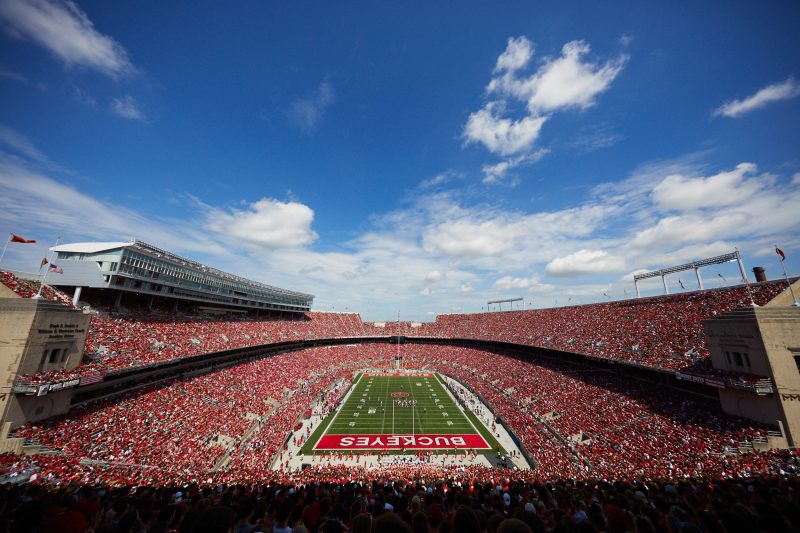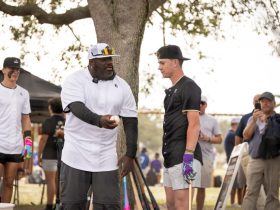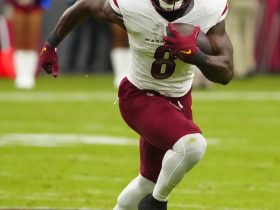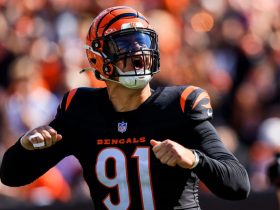College athletics directors are still absorbing the impacts and implications of the proposed settlement of three athlete-compensation antitrust lawsuits that the NCAA and the Power Five conferences approved last week. But one industry leader already has a prediction about a couple of steps that schools will be able to pursue to help offset a presumptive $2.8 billion in damages and billions more in future payments to athletes.
‘I believe the NCAA is going to allow us to put a sponsor logo on the field during the regular season,” Florida athletics director Scott Stricklin said Wednesday at the Southeastern Conference’s spring meetings in Miramar Beach, Florida. “That’s an obvious revenue stream that has not been there in the past. The pro sports are putting patches on jerseys. That doesn’t seem like something that’s crazy for us to consider these days.’
What are the NCAA rules governing on-field sponsors?
At present, the NCAA Division I Manual and the NCAA Football Rules have tight restrictions on the use of commercial logos. However, an association committee composed of representatives from all three competitive divisions has added to its agenda for a June 6 meeting a proposal that could change some of these restrictions, an NCAA spokesperson said late Wednesday afternoon. Schools could be allowed to have a corporate logo as part of the midfield decor, as is allowed for bowl games and neutral-site games with title sponsors.
Known as the NCAA Playing Rules Oversight Panel, the committee’s charge includes reviewing “playing-rules proposals, especially those involving player safety, financial impact or image of the game,” according to the NCAA’s website. Its current chair, according to the NCAA’s website, is SEC associate commissioner Tiffany Daniels.
Under the football rules, advertising on the field currently is prohibited except for “postseason and neutral-site games the title sponsor whose name is associated with the name of that game … with the restriction that there be a maximum of three such advertisements: a single advertisement centered on the 50-yard line and no more than two smaller flanking advertisements.”
The football rules also say: “If a commercial entity or individual has purchased naming rights to the stadium, facility, or field, that entity’s or individual’s name/ company-specific font or logo may be painted on the field in no more than two” maximum allowable total of four ‘flanking locations” to the midfield area.
The NCAA Division I Manual says athletes’ uniforms and other apparel “shall bear only a single manufacturer’s or distributor’s normal label or trademark (regardless of the visibility of the label or trademark), not to exceed 2-1/4 square inches in area (rectangle, square, parallelogram) including any additional material (e.g., patch) surrounding the normal trademark or logo.” The Manual even has a rule that applies if the uniform or apparel item carries “washing instructions on the outside of the apparel on a patch that also includes the manufacturer’s or distributor’s logo or trademark.”
Jeff Nelson, the president of Navigate — a firm that specializes in college and professional sports rights valuations — told USA TODAY Sports last week that there are “a lot of revenue streams that, frankly, have not been optimized” in college sports and could be tapped without college sports losing their distinct character.
What other revenues are possible for college athletics programs?
And Stricklin expressed some thoughts about enterprises beyond corporate logos.
“One of the biggest drivers, it seems to me, on people paying attention to pro sports is fantasy sports,” Stricklin said. “Is fantasy sports for college athletics that’s licensed with real player names and they get a cut and the school gets a cut and it gets people involved? Is that something we should consider? I think any and all of those should be on the table.’
SEC commissioner Greg Sankey, in comments Tuesday, said none of the type of corporate activity being considered by the NCAA committee is new to college sports. “We’ve had jersey patches in bowl games,” he said. “I would anticipate there’s going to be a continuing push (for new revenues), and we’re going to have to come to some agreement in this new environment on where those limits exist.”
Alabama AD Greg Byrne was asked Wednesday whether his school would be interested in new revenue opportunities such as logos on field and corporate jersey patches.
His reply: “We’re pretty traditional. I think it’s cool that Alabama doesn’t change their jerseys. We’re unique in that way now. And so, you never say never, but we obviously are fairly conservative when it comes to what we do in anything like that.”
But Byrne also said, referring to revenue-sharing with athletes: ‘We’re going to have to figure out how to pay for the new line item in our budget. Is there an opportunity for revenue growth? There’s always a rock you can look under.’
However, Byrne and Stricklin both said schools will need to examine not only revenue, but also spending.
Stricklin: “We have always been able to race our way to more revenue to prevent from having to make really hard decisions on the expense side. We’re going to have to make tough decisions on the expense side. We need to grow revenue at the same time, but we’re all going to rip open and do a total autopsy on every single part of our program’s economic health, and we’ll probably do things a little differently on the other side of that.”
Byrne: “As much as people think there’s unlimited money, there’s not. You have to make financial decisions. …
“I think we’re all going to have to be thoughtful on how we spend, where we spend. We can’t be top of the market at everything, and I’m at Alabama. Think about that, right? … We have to make challenging financial decisions at Alabama every single year. So if we have to do that, don’t you think everybody else does, too.”
Toppmeyer reported from Miramar Beach, Fla.








